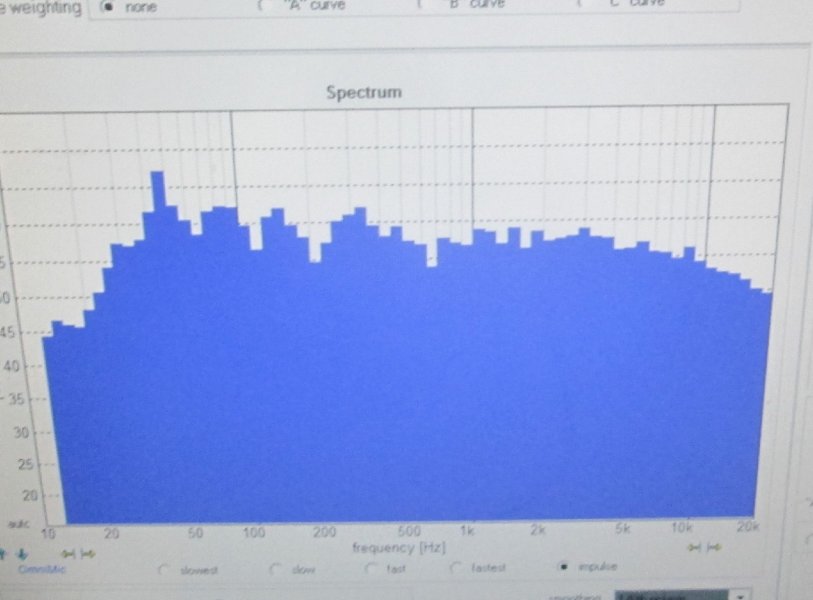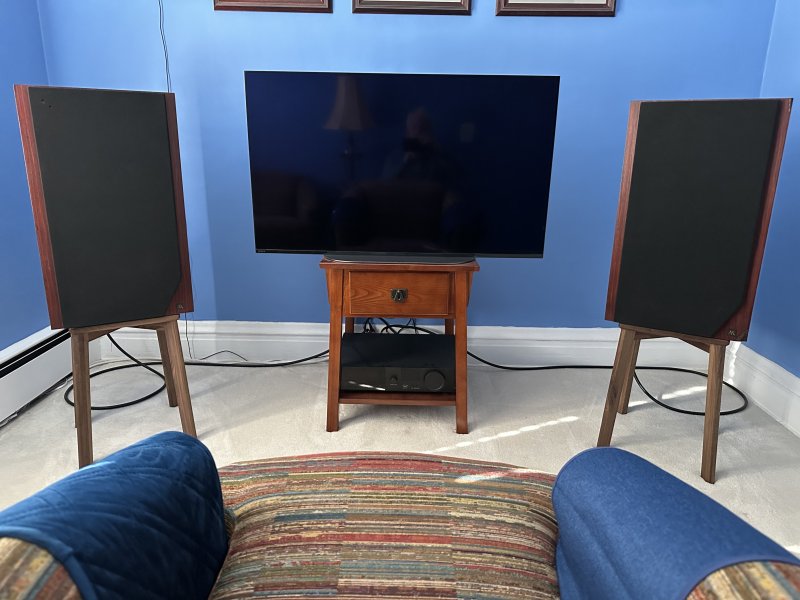For background on the new second system in which I'm using these speakers, see this post and this post, both of which are in my overall discussion of the Lyngdorf TDAI-3400. Like my primary system, this new second system in my Blue Room uses a TDAI-3400 for amplification and streaming. This second system, unlike my primary system, is also used for watching broadcast TV and streaming video services.
This is the second time I've owned the AR-303a speakers as vintage speakers. The first time around I wrote comparing their sound to the earlier-yet classic AR-3a speakers. See my "Vintage or Less Vintage: The AR-3a vs. the AR-303a" thread. More comments by me about the AR-3a are in my sticky thread, "The 12 Most Significant Loudspeakers of All Time" at #2.
The first time I used the 303a speakers was in a large living room, bi-amplified by four channels of an Arcam AVR600 A/V receiver (highly rated at the time by Peter Moncrieff of International Audio Review [IAR]). The speakers were on 24-inch high stands, aimed straight ahead (no toe in) and I sat back about 10 feet from them. The first time around I had issues with forwardness/brightness in the 2 - 5 kHz region.
This time, the speakers are single-amped, single wired with Benchmark speaker cables from the Lyngdorf TDAI 3400. The speakers sit on lower 18-inch-high stands (these stools, actually), are toed in to face their respective ears, and I listen in the near field, about 50 inches from my ears to the drivers. As toed in in my set up, the center fronts of the baffles are about 62 1/4 inches apart. Thus, the subtended angle between the speakers from the listening position may be viewed as somewhat greater than the "standard" 60 degrees. However, since I have the speakers set up with the offset midrange and tweeter on the inside, the subjective separation may be somewhat reduced. My ears in my unmodified present chair are an inch or two below the tweeter level. The top center front of each speaker is 23 3/4 inches from the sidewall, 30 1/8 inches from the wall behind the speakers, and the woofer centers are about 26 inches above the floor. The tweeters are 39 inches above the floor. The Blue Room is very small, about 9 1/2 feet wide along the speaker wall by 9 feet, with an 8 1/2 foot ceiling. The room has plaster wall and ceiling construction and the floor is carpeted with thick cut-pile wall-to-wall carpeting over a thick pad. The speaker baffles are a few inches in front of the 42-inch flat screen Sony OLED TV.
Cutting to the chase, this time around not only are the bass and midrange extremely fine sounding for a vintage speaker of this cost (you can find them online these days for around $1,200 a pair asking price), but the highs are also now correctly balanced and very fine sounding as well.
I'm not sure which factors made the difference in my current vs. past reaction to the sound: biamping vs. single amping, no toe in vs. toed in, high stands vs. lower stands, ear height relative to the tweeter, far field vs. near field--or maybe a combination of two or more of these factors. But my reaction is now more in line with most of the other online and print reviews of the sound of these speakers.
As far as reviews by others go, I refer you to John Atkinson's Stereophile review and the attached review by Robert E. Greene done for the print version of The Absolute Sound in July 1996 but which is not available online as far as I can discover.
I can verify by adjusting my vertical seating position that Atkinson is right about needing to sit on or just below the tweeter axis to get the best high frequencies from these speakers. My current small Drexel/Heritage chair was still about an inch too low even though I placed a Target shelf beneath the seat cushion to raise my ear height a couple of inches. I have ordered a pair of Penny Mustard barrel chairs for this Blue Room which I should receive by mid-January and which I know from experience (I have three of these same chairs in a downstairs room already) will raise my sitting position to 39 inches, which is right on axis with the tweeter with the speakers on their 18-inch stands. This ear height is more crucial in my current near field listening positon, of course, for simple geometric reasons. For the present, I have achieved this 39i-inch ear height by adding this gel cushion below the seat cushion of the chair instead of the Target shelf.
I hear the "roughness" REG refers to in his review but, oddly, this quality seems to diminish with proper listening axis (toed in and ear height relative to the tweeter) and near field listening. And while I hear a slight foreshortening of the depth of field compared to that from other speakers mentioned by both Atkinson and Greene, in this near-field set up, there is still enough depth and three dimensionality to satisfy, even on large-scale orchestral music.
What I now have is truly excellent vintage speaker sound. And the bass! I again find myself marveling at its depth, power, fullness, cleanness, and overall rightness. Even larger stand-mount speakers like the Harbeth 40s can't match these acoustic suspension ARs in the mid- to low-bass department.
This is the second time I've owned the AR-303a speakers as vintage speakers. The first time around I wrote comparing their sound to the earlier-yet classic AR-3a speakers. See my "Vintage or Less Vintage: The AR-3a vs. the AR-303a" thread. More comments by me about the AR-3a are in my sticky thread, "The 12 Most Significant Loudspeakers of All Time" at #2.
The first time I used the 303a speakers was in a large living room, bi-amplified by four channels of an Arcam AVR600 A/V receiver (highly rated at the time by Peter Moncrieff of International Audio Review [IAR]). The speakers were on 24-inch high stands, aimed straight ahead (no toe in) and I sat back about 10 feet from them. The first time around I had issues with forwardness/brightness in the 2 - 5 kHz region.
This time, the speakers are single-amped, single wired with Benchmark speaker cables from the Lyngdorf TDAI 3400. The speakers sit on lower 18-inch-high stands (these stools, actually), are toed in to face their respective ears, and I listen in the near field, about 50 inches from my ears to the drivers. As toed in in my set up, the center fronts of the baffles are about 62 1/4 inches apart. Thus, the subtended angle between the speakers from the listening position may be viewed as somewhat greater than the "standard" 60 degrees. However, since I have the speakers set up with the offset midrange and tweeter on the inside, the subjective separation may be somewhat reduced. My ears in my unmodified present chair are an inch or two below the tweeter level. The top center front of each speaker is 23 3/4 inches from the sidewall, 30 1/8 inches from the wall behind the speakers, and the woofer centers are about 26 inches above the floor. The tweeters are 39 inches above the floor. The Blue Room is very small, about 9 1/2 feet wide along the speaker wall by 9 feet, with an 8 1/2 foot ceiling. The room has plaster wall and ceiling construction and the floor is carpeted with thick cut-pile wall-to-wall carpeting over a thick pad. The speaker baffles are a few inches in front of the 42-inch flat screen Sony OLED TV.
Cutting to the chase, this time around not only are the bass and midrange extremely fine sounding for a vintage speaker of this cost (you can find them online these days for around $1,200 a pair asking price), but the highs are also now correctly balanced and very fine sounding as well.
I'm not sure which factors made the difference in my current vs. past reaction to the sound: biamping vs. single amping, no toe in vs. toed in, high stands vs. lower stands, ear height relative to the tweeter, far field vs. near field--or maybe a combination of two or more of these factors. But my reaction is now more in line with most of the other online and print reviews of the sound of these speakers.
As far as reviews by others go, I refer you to John Atkinson's Stereophile review and the attached review by Robert E. Greene done for the print version of The Absolute Sound in July 1996 but which is not available online as far as I can discover.
I can verify by adjusting my vertical seating position that Atkinson is right about needing to sit on or just below the tweeter axis to get the best high frequencies from these speakers. My current small Drexel/Heritage chair was still about an inch too low even though I placed a Target shelf beneath the seat cushion to raise my ear height a couple of inches. I have ordered a pair of Penny Mustard barrel chairs for this Blue Room which I should receive by mid-January and which I know from experience (I have three of these same chairs in a downstairs room already) will raise my sitting position to 39 inches, which is right on axis with the tweeter with the speakers on their 18-inch stands. This ear height is more crucial in my current near field listening positon, of course, for simple geometric reasons. For the present, I have achieved this 39i-inch ear height by adding this gel cushion below the seat cushion of the chair instead of the Target shelf.
I hear the "roughness" REG refers to in his review but, oddly, this quality seems to diminish with proper listening axis (toed in and ear height relative to the tweeter) and near field listening. And while I hear a slight foreshortening of the depth of field compared to that from other speakers mentioned by both Atkinson and Greene, in this near-field set up, there is still enough depth and three dimensionality to satisfy, even on large-scale orchestral music.
What I now have is truly excellent vintage speaker sound. And the bass! I again find myself marveling at its depth, power, fullness, cleanness, and overall rightness. Even larger stand-mount speakers like the Harbeth 40s can't match these acoustic suspension ARs in the mid- to low-bass department.
Attachments
Last edited:










